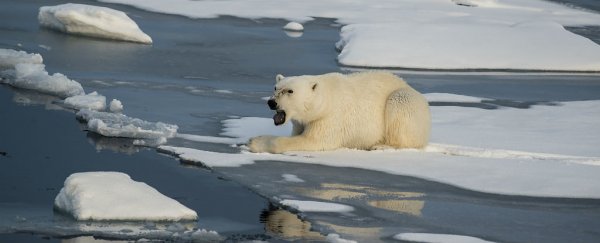Once 2016 comes to a close, the Arctic will have experienced its hottest year on record, and researchers have found that it's now warming twice as fast as any other place on Earth.
According to the US National Oceanic and Atmospheric Administration (NOAA)'s annual Arctic report card, there's been a "massive decline in sea ice and snow" in the Arctic region, with temperatures near the North Pole hitting an unheard of 20°C (36°F) warmer than average in November.
"Rarely have we seen the Arctic show a clearer, stronger, or more pronounced signal of persistent warming and its cascading effects on the environment than this year," said Jeremy Mathis, director of NOAA's Arctic Research Program.
The report, which compiles data from 61 scientists in 11 countries, found that air temperatures over the Arctic from October 2015 to September 2016 were "by far the highest in the observational record beginning in 1900".
It also concluded that the extent of sea ice in the region has decreased in all months of 2016 and in virtually all regions, with the exception being the Bering Sea during winter.
The report also revealed that there's a shift in the carbon cycle because of melting permafrost in the northern latitudes.
As CNN reports, because more carbon is stored in the permafrost than in Earth's atmosphere, if the permafrost is melting at unprecedented rates, that will increase the amount of CO2 and methane released into atmosphere. And there's already far too much in there.
More key findings of the report include:
- The average surface air temperature for the year ending September 2016 is by far the highest since 1900, and new monthly record highs were recorded for January, February, October, and November 2016.
- In 37 years of Greenland ice sheet observations, only one year had earlier onset of spring melting than 2016.
- Spring snow cover extent in the North American Arctic was the lowest in the satellite record, which started in 1967.
- After only modest changes from 2013 to 2015, minimum sea ice extent at the end of summer 2016 tied with 2007 for the second lowest in the satellite record, which started in 1979.
With a separate report from last week reporting that, as of December 4, we've lost 3.76 million square kilometres of sea ice from the Arctic and Antarctica - more than the total area of India - we've got a very big problem on our hands.
"Personally, I would have to say that this last year has been the most extreme year for the Arctic that I have ever seen," Mark Serreze, director of the US National Snow and Ice Data Centre in Boulder, Colorado, who wasn't part of the report, told the Associated Press.
"It's crazy."
The report can be access at the NOAA's website, and you can watch a video summary below:
